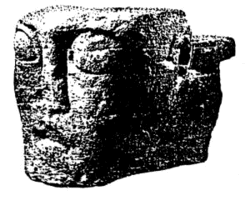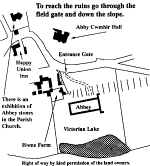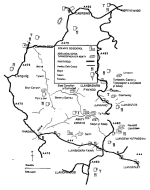ABBEY CWMHIR in RADNORSHIREHISTORY OF THE ABBEY
Abaty Cwmhir [Welsh language page] |
 |

Click for a larger image of the plan. |
 Click for a larger map. |
The Remains
The ruined abbey of Abbey Cwmhir, ‘the Abbey in the long Valley’, lies on the banks of the Clywedog brook amidst magnificent scenery in the centre of Powys. It is possible that the Abbey Church was never completed to the ambitious design of Llywelyn Fawr in the 13th century; but its 242 ft (74.5m) long nave has been exceeded by only two other churches in Britain, the cathedrals of Durham and Winchester.
The Abbey's Builders
The abbey was built by the Cistercian Order of monks (often called the White Monks because of their white habit), and the remoteness of its position is typical of sites chosen by them. Another characteristic of Cistercian settlements is that they were always sited near waterways - here the Clywedog Brook and its tributary that flows from Cwmpoeth. These enabled the monks to construct fisheries, run mills, and provide water for the monks' dwellings. The reason for the fisheries was that the fish formed an important part of their diet.
The remains of one of the Abbey fishponds lie near Fishpool Farm 2 miles farther up the valley. Llyn Gwyn, near Nant Glas, was also a fishery stocked by the Abbey and it is said that there are fish in it descended from those introduced by the monks.
The Cistercian Order with its severe simplicity of rule benefited the country both spiritually and economically. The monks obtained grants of unprofitable and barren land which they improved by the then modem methods of agriculture, thus greatly increasing its value and yield. They were great breeders of cattle, horses and sheep. They looked after invalids and the wounded, gave alms to the poor and shelter to travellers. Often the monks were the only people in the area who could read and write and they would give secretarial help to the local lords. Some of them became priests and would act as chaplains to the families of the aristocracy.
Abbey Cwmhir was dedicated to the Blessed Virgin Mary as were all Cistercian Abbeys and was intended for up to 60 monks plus lay brothers, servants and employees who lived outside.
The Abbey's Foundation
According to tradition the Abbey was originally founded by the king of Maelienydd (this part of Radnorshire), Maredudd ap Madog - cousin to Rhys ap Gruffudd (The Lord Rhys, King of Deheubarth). It is believed locally that it originally was near Ty Faenor about a mile eastward of the present site. The original foundation was abandoned within a year because the Anglo-Norman Mortimers of Wigmore conquered Maelienydd in 1144.
The Abbey was refounded in 1176 on the present site by Cadwallon ap Madog brother of Maredudd (who was killed by the Mortimers in 1146). The Lord Rhys had refounded Whitland Abbey (1155) and it was from Whitland that the first colony of monks came to Cwmhir after Rhys had expelled the Mortimers from Maeliennydd
The first buildings would have been of wood but as soon as possible the monks would have begun to build in stone using shale from local quarries, starting with the simple cross shaped church and then the dwellings of the monks and lay brothers.
History of the Abbey
The residence of Cadwallon ap Madog was probably at Castell Tinboeth, the ruins of which are visible on a hill to the east of Llananno. In 1179 he was killed (as were all his family) by the Mortimers of Wigmore who progressively conquered or annexed the eastern part of Mid Wales to their lands in England. By 1198 Maelienydd and the Abbey had fallen under Mortimer patronage, and in that year a number of monks left the Abbey to found a daughter house at Cymer near Dolgellau, that was still under Welsh rule. The Mortimers were reasonably generous to the Abbey, when the Monks supported them.
In 1214, King John of England took the Abbey and its possessions under his protection granting freedom from toils for their goods on condition that nothing bought or sold came into the hands of the king’s enemies.
In 1227 Llywelyn Fawr re-established Welsh control over Maelienydd and began to renovate the little church of the Abbey into a huge cathedral as a symbol of his recently united country. Today the remains of the abbey Church show the outline of the nave and the aisles and the west walls of the transepts. There were 14 arches of finely carved Grinshill sandstone on both sides of the nave which shows the grandeur of his concept. It is possible that the transepts and the chancel were never built, because of lack of money and political opposition, but their remains may lie below ground.
In 1231 during the war between Henry III of England and Llywelyn the Great a friar of the Abbey was accused of misdirecting the English army to an ambush in a marsh.
Henry III in revenge plundered and burnt the nearest Abbey grange and the Abbey itself was only saved by paying an enormous fine of 300 marks (possibly £300,000 in today's money). This is probably the reason that the Church was not finished in time for the crowning of David, son of Llywelyn that was held eventually at Strata Florida in 1238.
In the following year a writ of protection was issued by Henry exempting the monastery from paying tolls again on condition that the monks were loyal to him. In 1276 the then Abbot was one of the seven Welsh Cistercian superiors who appealed to the Pope to lift the excommunication placed on Llywelyn the Great's grandson Llywelyn ap Gruffudd. After Llywelyn had been beheaded in 1282 and his head sent to London, his body was taken by the monks and buried secretly in the Abbey (unknown to the Welsh).
Like the majority of Welsh Cistercian houses, from their foundation to the fifteenth century, Cwmhir supported the Welsh princes and was consequently penalised by the Marcher Lords and the English Crown. In 1318 Edward II of England confirmed the grants bestowed on the Cisterians by his predecessors, John and Henry but the Abbey’s relations with the Mortimers continued to be strained throughout the century.
Things were different during Owain Glyndwr's war of Independence. In the autumn of 1401 Hugh Burnell who had defeated Owains's supporters at Welshpool was appointed as overseer of Radnorshire. The country people of Maelienydd and other Mortimer lands in Wales took up arms in support of Owain Glyndwr. Through the winter and spring Owain's army attacked towns and villages in the area controlled by the Mortimers burning many of them. The Cwmhir Abbey unable to give support to Owain Glyndwr because it was under the patronage of the Mortimers was attacked and burnt.
Owain's army defeated Edmund Mortimer's army (a mixture of English and Welsh men) at the battle of Bryn Glas (Pilleth) in June 1402. Edmund Mortimer was captured and held as hostage. After marrying Glyndwr's daughter Catrin he became one of his supporters. Although Owain's Principality gradually faded from 1405 till his death 1415, the uplands of Radnorshire remained loyal to his vision till the 1440s. On the accession in 1461 of Edward IV (nephew of Edmund Mortimer), the Abbey and its possessions became Crown property. The Abbey possessed a ‘famed picture of Jesus’ which brought pilgrims to the Abbey but it was not as rich as other abbeys because it did not have income from wealthy churches and had lost the patronage both of Welsh Princes and of the English Mortimers.
Dissolution of the Abbey
Henry VIII (of England) sent Commissioners to every abbey in 1535 to enquire into income and property. Every abbey with an income of less than £200 pa was to be dissolved and the monks quietly dispersed.
In 1539 the possessions of the Abbey were granted for 21 years to John Turner, the King of England's agent and were eventually sold in various ways on behalf of the King. In 1565 Queen Elizabeth granted a licence for the transfer of the Abbey lands to William Fowler of Middle Temple and Harnage near Shrewsbury in whose family it remained until the end of the 18th century.
The solid Abbey buildings which were probably used by the Fowlers as their mansions were fortified by Richard Fowler during the English civil war and held for the Royalists. It was stormed in 1644 by Sir Thomas Middleton who had been sent by General Fairfax to take and destroy it and he succeeded in doing this. In a letter dated December 1644 Middleton describes the storming of that 'very strong house built with stone of great thickness, having been in former times an abbey of the Papists and now by the mighty hand of God delivered into our hands’ – with the help of canon.
After the war Richard Fowler built a new mansion house in 1650 at Devannor (Ty Faenor) mentioned previously, using stone from the ruined abbey buildings. His son built the first village church from the same source in 1686. From the Fowler family the Abbey and its lands passed by marriage to Thomas Hodges and then to Francis Hans Hastings afterwards Earl of Huntington.
Thomas Wilson bought the bankrupt estate in 1824 and proceeded to develop it, building the first Elizabethan style Abbey Cwmhir Hall in 1833 and rebuilding many estate houses using material from the Abbey buildings. On his emigration to Australia in 1837 Francis Philips purchased the estate. His daughter rebuilt the village church in 1866 and his son extended the Hall in 1867.
In 1869 Lady Jane Williams discovered letters by Peckham, (Archbishop of Canterbury in 1282) in the English Court Records suggesting that Llywelyn was buried in the Abbey. At last the secret was known but there is no indication of where in the Abbey Church the body was laid.
The Last Remains
Thomas Wilson cleared the ruins down to floor level (1827) discovering in the process human bones, ironwork, painted glass, coins of Edward II, carved heads, keys and other remians together with some blue black tiles similar to those found in Strata Florida. In the northeastern part of the nave was discovered a stone coffin lid bearing the inscription 'Hic iacet Mabli, cujus animae propitieur deus.' which roughly translated means "Here lies Mabli to whom God be merciful". Nobody knows who Mabli was. The carving on the stone is in the style of 13th century and it may now be seen in the west end of the nave of the Parish church. A carved head of similar date may be seen in the Radnorshire Museum in Llandrindod.
Outside the Abbey Church the sites of the Abbots dwelling, the refectory, dormitories and the Abbot's house were traced. A strong dyke and entrenchment crossed the valley at equal distances east and west of the church enclosing about ten acres of land forming the boundaries of the ancient privilege of sanctuary. Jenkins Rees published a plan of the site in 1849 and Stephen Williams made minor excavations on the site in 1889 and 1894.
The most important and perfect remains of the Abbey Church are to be seen in Llanidloes church about 14 miles away to the north west of the abbey. In 1542 five arches from the north eastern end of the Abbey church and the north western pillar of the crossing were used to enlarge the church there. The wooden roof is also likely to have come from the Abbey buildings.
In two local churches Llananno and Cefnllys there are carved wooden screens which may have come from the Abbey and there are pieces of the Grinshill sandstone that was used for pillars and windows of the Abbey church in a number of churches like Llanbister, Llanddewi Ystradenni and Llandegley - some times as windows or decoration, sometimes as part of the walls. The honey coloured stone can he seen also in the walls of farmhouses and barns and garden walls. (For more detail's see the pamphlet 'The Stones of Abbey Cwmhir' also published in this series by the Abbey Cwmhir Trust.)
